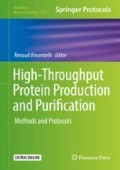Abstract
Protein kinases are major targets for the development of new medicines and play key roles in cellular signaling. The flexible nature of these proteins, posttranslational modifications, and the large size of some protein kinases pose a particular challenge obtaining homogeneous, active recombinant protein kinases suitable for functional or structural studies. Here we describe our expertise expressing protein kinases in two frequently used host systems: E. coli and insect cells using the baculovirus expression vector system. In particular, we will discuss and provide detailed methods on construct design, high-throughput cloning, parallel expression testing and scale up as well as purification and co-expression strategies leading to stable and homogeneous recombinant protein samples.
Access this chapter
Tax calculation will be finalised at checkout
Purchases are for personal use only
References
Manning G, Whyte DB, Martinez R, Hunter T, Sudarsanam S (2002) The protein kinase complement of the human genome. Science 298(5600):1912–1934. https://doi.org/10.1126/science.1075762
Soundararajan M, Roos AK, Savitsky P, Filippakopoulos P, Kettenbach AN, Olsen JV, Gerber SA, Eswaran J, Knapp S, Elkins JM (2013) Structures of down syndrome kinases, DYRKs, reveal mechanisms of kinase activation and substrate recognition. Structure 21(6):986–996. https://doi.org/10.1016/j.str.2013.03.012
Kornev AP, Haste NM, Taylor SS, Eyck LF (2006) Surface comparison of active and inactive protein kinases identifies a conserved activation mechanism. Proc Natl Acad Sci U S A 103(47):17783–17788. https://doi.org/10.1073/pnas.0607656103
Nolen B, Taylor S, Ghosh G (2004) Regulation of protein kinases; controlling activity through activation segment conformation. Mol Cell 15(5):661–675. https://doi.org/10.1016/j.molcel.2004.08.024
Oliver AW, Knapp S, Pearl LH (2007) Activation segment exchange: a common mechanism of kinase autophosphorylation? Trends Biochem Sci 32(8):351–356. https://doi.org/10.1016/j.tibs.2007.06.004
Shrestha A, Hamilton G, O’Neill E, Knapp S, Elkins JM (2012) Analysis of conditions affecting auto-phosphorylation of human kinases during expression in bacteria. Protein Expr Purif 81(1):136–143. https://doi.org/10.1016/j.pep.2011.09.012
Filippakopoulos P, Kofler M, Hantschel O, Gish GD, Grebien F, Salah E, Neudecker P, Kay LE, Turk BE, Superti-Furga G, Pawson T, Knapp S (2008) Structural coupling of SH2-kinase domains links Fes and Abl substrate recognition and kinase activation. Cell 134(5):793–803. https://doi.org/10.1016/j.cell.2008.07.047
Linding R, Russell RB, Neduva V, Gibson TJ (2003) GlobPlot: exploring protein sequences for globularity and disorder. Nucleic Acids Res 31(13):3701–3708
McGuffin LJ, Bryson K, Jones DT (2000) The PSIPRED protein structure prediction server. Bioinformatics 16(4):404–405
Varshavsky A (1997) The N-end rule pathway of protein degradation. Genes Cells 2(1):13–28
Haun RS, Serventi IM, Moss J (1992) Rapid, reliable ligation-independent cloning of PCR products using modified plasmid vectors. BioTechniques 13(4):515–518
Strain-Damerell C, Mahajan P, Gileadi O, Burgess-Brown NA (2014) Medium-throughput production of recombinant human proteins: ligation-independent cloning. Methods Mol Biol 1091:55–72. https://doi.org/10.1007/978-1-62703-691-7_4
Geertsma ER, Dutzler R (2011) A versatile and efficient high-throughput cloning tool for structural biology. Biochemistry 50(15):3272–3278. https://doi.org/10.1021/bi200178z
Burgess-Brown NA, Mahajan P, Strain-Damerell C, Gileadi O, Graslund S (2014) Medium-throughput production of recombinant human proteins: protein production in E. coli. Methods Mol Biol 1091:73–94. https://doi.org/10.1007/978-1-62703-691-7_5
Vaughn JL, Goodwin RH, Tompkins GJ, McCawley P (1977) The establishment of two cell lines from the insect Spodoptera frugiperda (Lepidoptera; Noctuidae). In Vitro 13(4):213–217
Wickham TJ, Davis T, Granados RR, Shuler ML, Wood HA (1992) Screening of insect cell lines for the production of recombinant proteins and infectious virus in the baculovirus expression system. Biotechnol Prog 8(5):391–396. https://doi.org/10.1021/bp00017a003
Mahajan P, Strain-Damerell C, Gileadi O, Burgess-Brown NA (2014) Medium-throughput production of recombinant human proteins: protein production in insect cells. Methods Mol Biol 1091:95–121. https://doi.org/10.1007/978-1-62703-691-7_6
Seeliger MA, Young M, Henderson MN, Pellicena P, King DS, Falick AM, Kuriyan J (2005) High yield bacterial expression of active c-Abl and c-Src tyrosine kinases. Protein Sci 14(12):3135–3139. https://doi.org/10.1110/ps.051750905
Acknowledgements
The authors are grateful for financial support by the SGC, a registered charity (number 1097737) that receives funds from AbbVie, Bayer Pharma AG, Boehringer Ingelheim, Canada Foundation for Innovation, Eshelman Institute for Innovation, Genome Canada through Ontario Genomics Institute, Innovative Medicines Initiative (EU/EFPIA) [ULTRA-DD grant no. 115766], Janssen, Merck & Co., Novartis Pharma AG, Ontario Ministry of Economic Development and Innovation, Pfizer, São Paulo Research Foundation-FAPESP, Takeda, the Centre of Excellence (CEF) Macromolecular Complexes at Frankfurt University, and the Wellcome Trust. SK and SM are grateful for support by the German Cancer Centre (DKFZ) and the German Cancer Network (DKTK).
Author information
Authors and Affiliations
Corresponding author
Editor information
Editors and Affiliations
Rights and permissions
Copyright information
© 2019 Springer Science+Business Media, LLC, part of Springer Nature
About this protocol
Cite this protocol
Mathea, S., Salah, E., Knapp, S. (2019). High-Throughput Purification of Protein Kinases from Escherichia coli and Insect Cells. In: Vincentelli, R. (eds) High-Throughput Protein Production and Purification. Methods in Molecular Biology, vol 2025. Humana, New York, NY. https://doi.org/10.1007/978-1-4939-9624-7_8
Download citation
DOI: https://doi.org/10.1007/978-1-4939-9624-7_8
Published:
Publisher Name: Humana, New York, NY
Print ISBN: 978-1-4939-9623-0
Online ISBN: 978-1-4939-9624-7
eBook Packages: Springer Protocols

